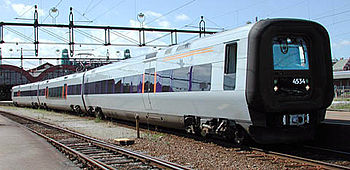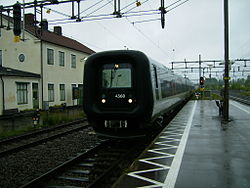- Oresundtrain
-
Oresundtrain or Øresundståg (Swedish: Öresundståg, Danish: Øresundstog) is a regional rail (in Denmark outer suburban rail) network serving the Oresund Region. The train consists of multiple units manufactured by Bombardier Transportation in Kalmar, previously known as Kalmar Verkstad and lately in Hennigsdorf by LEW Hennigsdorf. They run at 20 minute intervals between Helsingør, Copenhagen in Denmark and Malmö, Lund in southern Sweden, once per hour during the night. From Lund some Oresundtrains continue to Gothenburg, Kalmar and Karlskrona. This schedule is augmented by a weekday service between Nivå and Copenhagen Airport, Kastrup with some rush hour services continuing across the Øresund to Malmö and Lund, effectively giving a 10-minute frequency on the route between Lund and Copenhagen Central Station and even more frequent service between Helsingør and Copenhagen.
Contents
Usage
Most of the trains on the Oresundtrain network are operated by DSBFirst, a joint operation between DSB and First Group, but a few are operated by DSB on the inter-city line to Ystad, where they connect to the high-speed ferry to Bornholm. This connection (train + ferry) is considered a DSB inter-city service for ticketing purposes. The travel time to Bornholm has been cut in half (3 hours vs 6 hours previously) since the opening of the Oresund bridge and the introduction of a high-speed ferry, thus becoming more competitive against air travel (35min flying time plus 30 min check-in time). The Oresundtrain units are also used on some regional pågatågen services Malmö-Helsingborg.
Rolling stock
The trains used are the fourth and latest generation of the IC3 family of multiple units, specifically designed for use in regional traffic in areas connected by the Oresund Railway. They are electrically powered, and can run on both the Danish power supply (25 kV, 50 Hz) and the Swedish power supply (15 kV, 16 2/3 Hz). Named Contessa by its manufacturer Bombardier,[1] they are designated Litra ET in Denmark and Littera X31K (where X means electric multiple unit, and K means allowed to go to Copenhagen) in Sweden . The chassis is manufactured entirely of stainless steel, painted in a light shade of gray. Roughly half of the trains are owned by DSB and the other half by SJ AB.
Each trainset is 79 metres in length and weighs about 157 metric tons. The trainset consists of three carriages, giving a weight of about 52 metric tons per unit. Eight of the train's 12 axles are powered, which gives good acceleration. The train's top speed is 180 km/h. Each train costs 67 million Swedish kronor (2006), equivalent to 22 million kronor per unit.
The train has a total of 196 seats (65 per carriage unit), of which some are in a low floor carriage in the middle.
The train type is nicknamed "Oresundtrain", but they are used not only for the Oresundtrain network traffic, but also for some local Scania traffic, for the DSB intercity trains Copenhagen-Ystad, and some of the SJ intercity trains Copenhagen-Gothenburg. This other traffic is not part of the Oresundtrain traffic since that a brand name, but is sometimes called that anyway.
Traffic
On the Danish side the trains stop often, about every 4 km, like a commuter train. On the Swedish side the trains stop much less often, more like inter-city trains, and they reach stations about 300 km from Copenhagen, like Gothenburg, Kalmar and Karlskrona.
Over the Oresund bridge the trains run three times, rush hour six times per hour per direction, with up to three sets coupled together, creating 237 metre long trains with 588 seats, providing a capacity of 1764 (3528) seats per hour. Increasingly this has turned out to be insufficient, and people have to stand during rush hours (into Copenhagen in the morning and to Malmö in the afternoon). The differences in salaries and house prices between Copenhagen and Malmö create interest in cross-border commuting. The trains cannot be lengthened because of platform length constraints. Earlier, the number of trains were limited to three per hour per direction because of limited Malmö C station capacity due to the need for reversal there, now obviated by the recently opened Malmö City Tunnel.
The combination of train tours of inter-city type in Sweden with commuter-like train tours in Denmark is often a source of trouble. The long-distance trains from Sweden has often got delays during the long ride. But delays cause trouble to commuter passengers having fixed work hours and don't want to add long margins, since they travel every day. Therefore DSBFirst nowadays have trains ready at Kastrup that go to Helsingør if the train from Sweden is delayed. In that case the train from Sweden does not go all the way to Helsingør.
Operators
Passengers can encounter both Danish and Swedish DSBFirst staff on the trains over the Öresund Bridge. Tickets can be bought from either country and are valid on all trains. For travel inside one of the Swedish counties or inside Denmark, the local traffic authority tickets are used. For travel across county borders special Oresundtrain tickets are used, which are sold by the local traffic authority on selected locations.
Competitors
Between Gothenburg and Copenhagen (but not to Helsingør), the SJ AB operates competing trains. From 2009 they have different tickets compared to the Oresundtrain services. SJ runs X2000 trains via Hässleholm, and from 2009 intercity trains using type X31 via Helsingborg. The X31 train type is often called "Oresundtrain" which is a source of confusion. Different tickets are needed. A passenger with an Oresundtrain ticket is not allowed to board an SJ train of the "Oresundtrain" model. A similar situation is with the DSB trains to Ystad, which do not allow Oresundtrain tickets despite the nickname of the vehicle.
Line chart and stations




Gothenburg Central Station Line 100 



Mölndal Line 100 



Kungsbacka Line 100 



Varberg Line 100 



Falkenberg Line 100 



Halmstad Line 100 







Kalmar Line 95 



Nybro Line 95 



Emmaboda Line 95 







Karlskrona Line 90 



Bergåsa Line 90 



Ronneby Line 90 



Bräkne-Hoby Line 90 



Karlshamn Line 90 



Mörrum Line 90 



Sölvesborg Line 90 



Bromölla Line 90 



Kristianstad Line 90 







Lessebo Line 95 



Hovmantorp Line 95 



Växjö Line 95 



Alvesta Line 95 



Älmhult Line 95 



Osby Line 95 







Laholm Line 100 



Båstad Line 100 



Ängelholm Line 100 



Helsingborg Line 100 



Landskrona Line 100 





Hässleholm Lines 90 and 95 



Höör Line 95 



Eslöv Line 95 











Lund Central Station Lines 90, 95 and 100 







City Tunnel, Malmö 



Malmö Central Station Lines 90, 95, 100 and 101 



Triangeln 







Hyllie 

Öresund Bridge Border: Sweden/Denmark 



Copenhagen Airport, Kastrup Lines 90, 95, 100 and 101 



Tårnby Lines 90, 95, 100 and 101 



Ørestad Lines 90, 95, 100 and 101 



Copenhagen Central Station Linje 90, 95, 100 and 101 



Nørreport Lines 90, 95, 100 and 101 



Østerport Lines 90, 95, 100 and 101 



Hellerup Lines 90, 95, 100 and 101 



Only Oresundtrains which originate in Copenhagen Airport (rush hour also from Sweden) stop between Hellerup and Kokkedal 



Klampenborg 



Skodsborg 



Vedbæk 



Rungsted Kyst 

Kokkedal Lines 90, 95, 100 and 101 



Nivå Lines 90, 95, 100 and 101 



Humlebæk Lines 90, 95, 100 and 101 



Espergærde Lines 90, 95, 100 and 101 



Snekkersten Lines 90, 95, 100 and 101 



Helsingør Lines 90, 95, 100 and 101 The line numbers are the one used by SJ. They are not used by any Danish operator.
Current status
Today three trains, rush hour six per hour both ways run over the Oresund Bridge.
On 27 June 2007 it was decided that DSBFirst was to assume responsibility for running all Oresundtrains on the Oresund Railway and connected destinations from 2009. DSBFirst started operations on 11 January 2009. In 2011, the Danish and Swedish ministries of transportation instructed DSBFirst to cease operations in Sweden from 10 December 2011, but DSBFirst will continue operations on the Danish part of its current network.[1][2] The Oresundtrain has suffered from both financial issues as well as delays and cancelled trains on both the Danish and Swedish part of the Oresundtrain network,[3][4][5][6] notably during the 2010 winter.
References
- ^ "Contessa Electric Multiple Unit - Denmark and Sweden". http://www.bombardier.se/en/transportation/products-services/rail-vehicles/intercity-trains/multiple-units/contessa---denmark-and-sweden-?docID=0901260d8001017a. Retrieved 2008-07-30.
External links
- Official Swedish website of Öresundståg (English) (Swedish)
Categories:- Transport in Copenhagen
- Oresund Line
Wikimedia Foundation. 2010.


